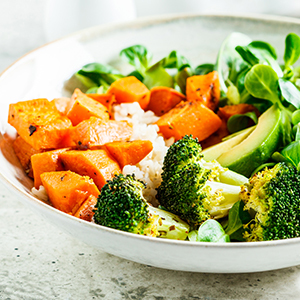
Is quinoa a healthier option than brown rice? As more supermarkets begin lining their shelves with this ancient, grain-like seed, consumers are asking this very question. Quinoa, a complete protein seed that resembles a cross between couscous and short-grain rice, is a popular swap for rice. Thanks to the increased attention praising its benefits, quinoa is becoming commonplace in many homes throughout the country. While brown rice is better than white rice, quinoa may provide a higher proportion of nutrients and could be a better option all around.
Quinoa vs. Brown Rice: Nutritional Comparison
When comparing quinoa with brown rice, quinoa wins every time. Quinoa has a higher fiber content, a lower glycemic load, and substantially more amino acids. Quinoa is one of the rare complete protein foods, meaning it contains all essential amino acids needed for growth, cellular repair, and energy production.[1] Here's a quick nutritional comparison of quinoa and brown rice:
Quinoa, 1 cup cooked
- Calories: 222
- Protein: 8 grams
- Magnesium: 30%
- Iron: 15%
Brown Rice, 1 cup cooked
- Calories: 216
- Protein: 5 grams
- Magnesium: 21%
- Iron: 5%
With few exceptions, quinoa is much more nutrient-dense than brown rice. That’s not to say brown rice is totally worthless, it is a good source of nutrition, but quinoa offers a higher nutrient content (including antioxidants), which helps support a superior state of health.
Saponins
A few years ago, there was a myth that quinoa was poisonous because it contains compounds called saponins. This rumor could not be further from the truth. Quinoa does contain saponins, but saponins are actually beneficial to your health. Saponins are a diverse group of phytochemicals that are produced naturally in many plants, including quinoa. They have a unique chemical structure that produces foam when mixed with water, much like a detergent. This unique structure gives them a multitude of health benefits, including loosening mucus, reducing occasional redness and swelling, protecting blood vessels, promoting balanced cholesterol, boosting immune function, and encouraging normal blood sugar. Saponins may help the body resist harmful organisms, and are even being investigated for their action against more serious health conditions.[2]
Why I Recommend Quinoa
References (2)
- Abugoch, James LE. "Quinoa (Chenopodium quinoa Willd.): composition, chemistry, nutritional, and functional properties." Advances in Food and Nutrition Research. 2009;58:1-31. doi: 10.1016/S1043-4526(09)58001-1.
- Podolak, Irma, Agnieszka, Galanty, and Danuta Sobolewska. "Nutritional quality of the protein in quinoa (Chenopodium quinoa, Willd) seeds." Phytochemistry Reviews 9.3 (2010): 425–474. PMC. Web. 10 Mar. 2017.
†Results may vary. Information and statements made are for education purposes and are not intended to replace the advice of your doctor. If you have a severe medical condition or health concern, see your physician.







